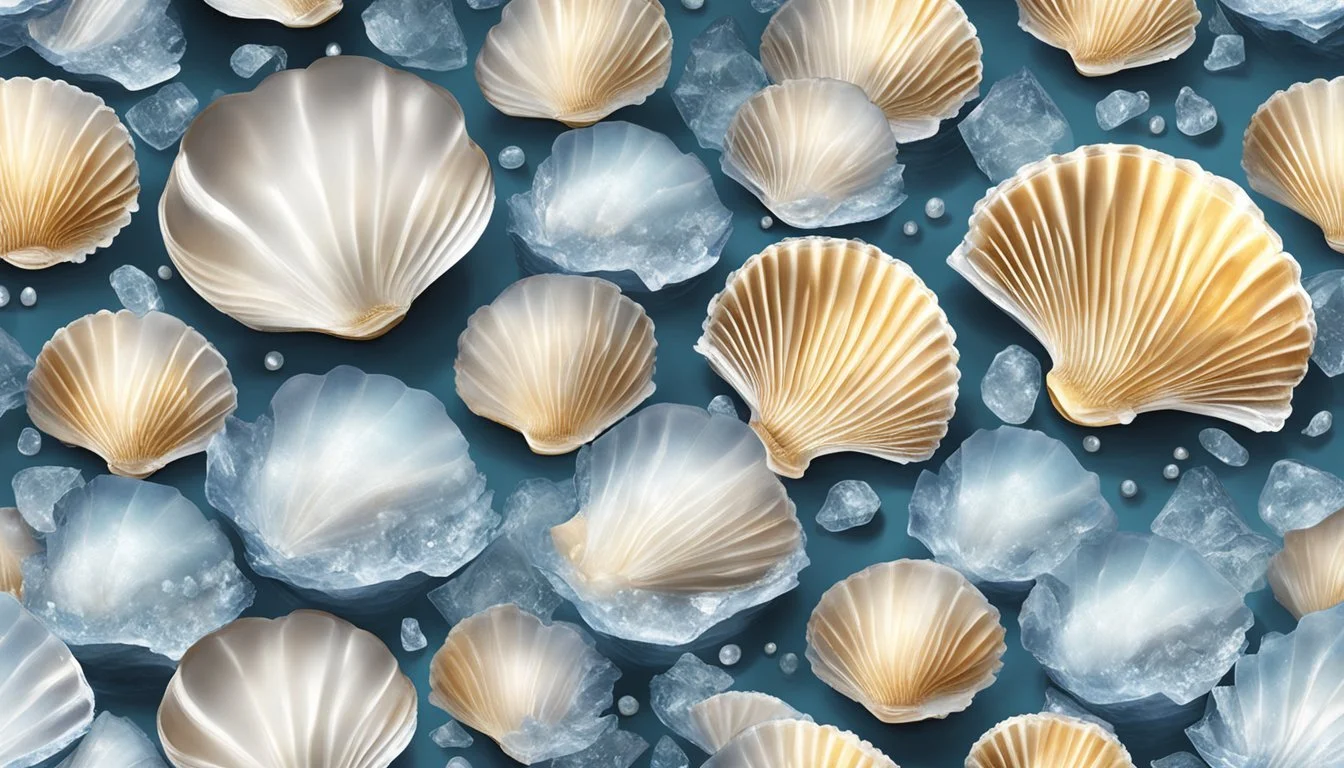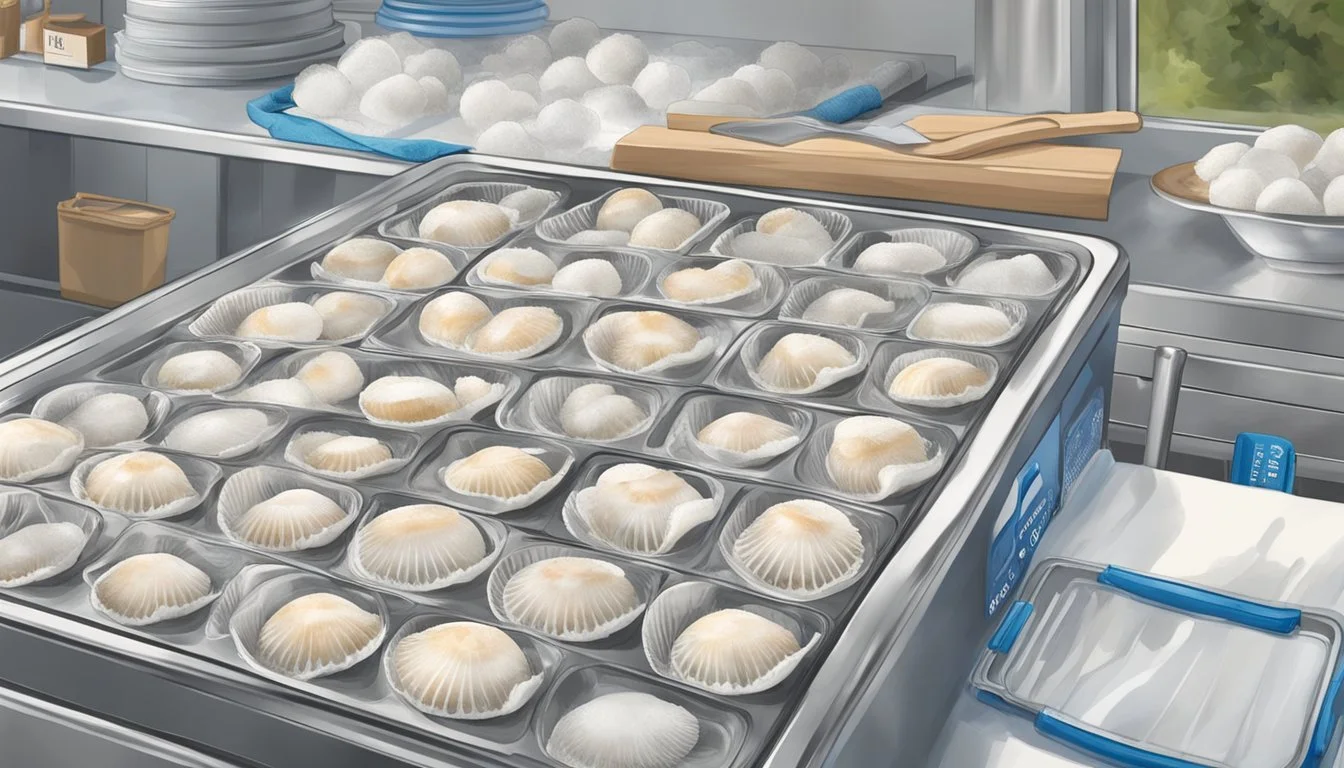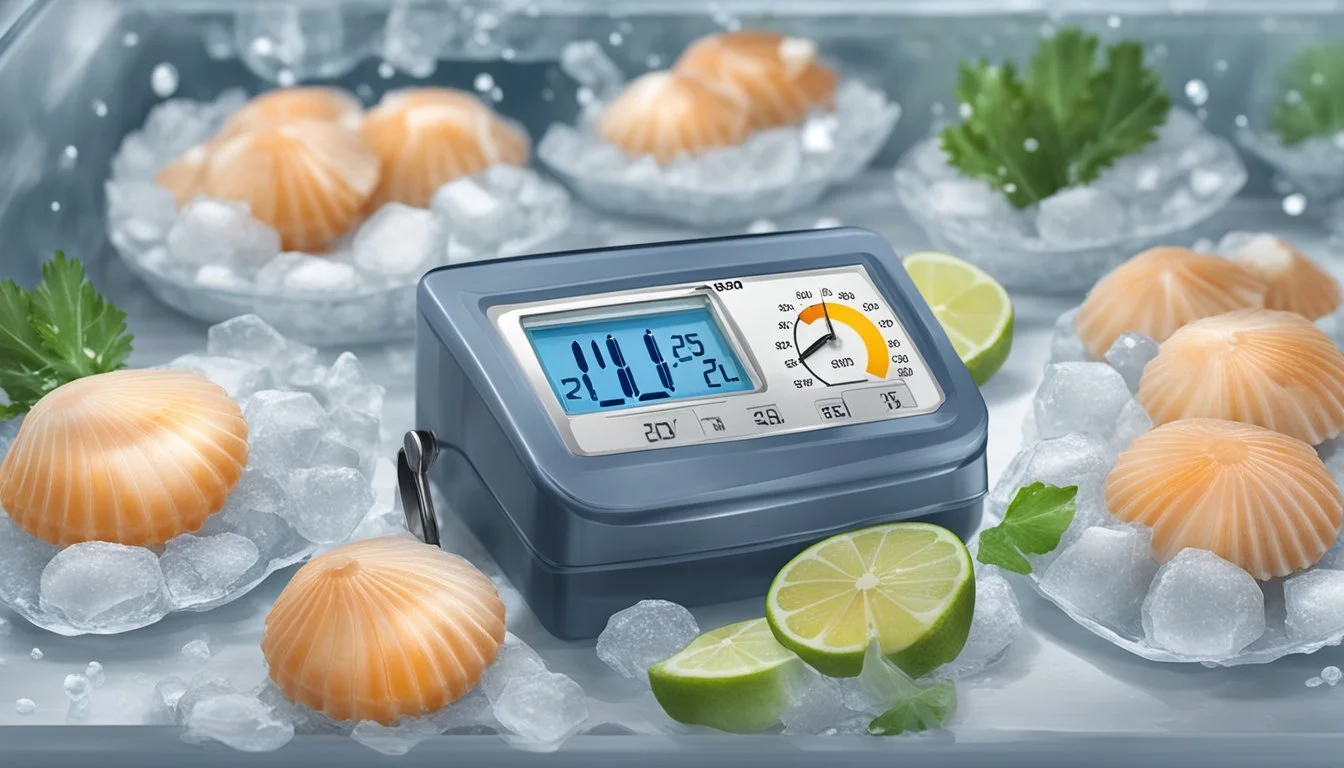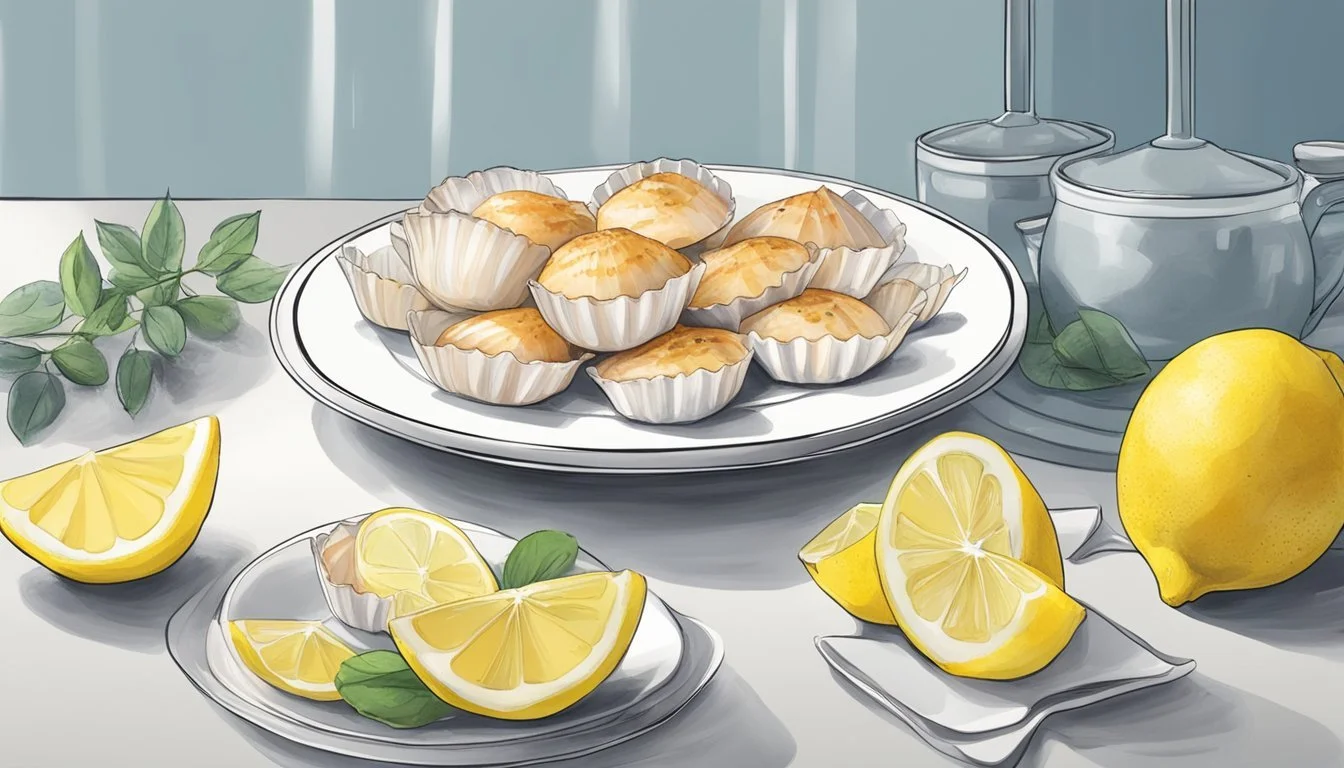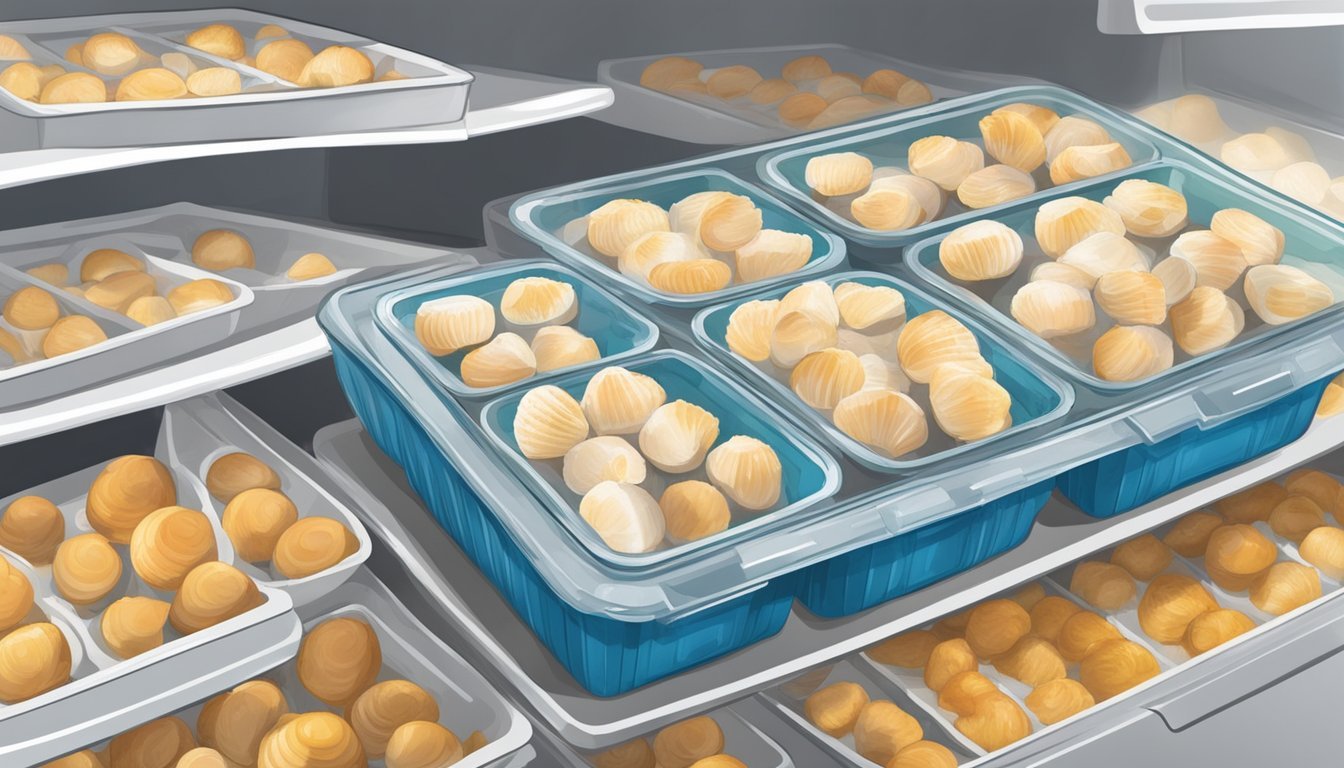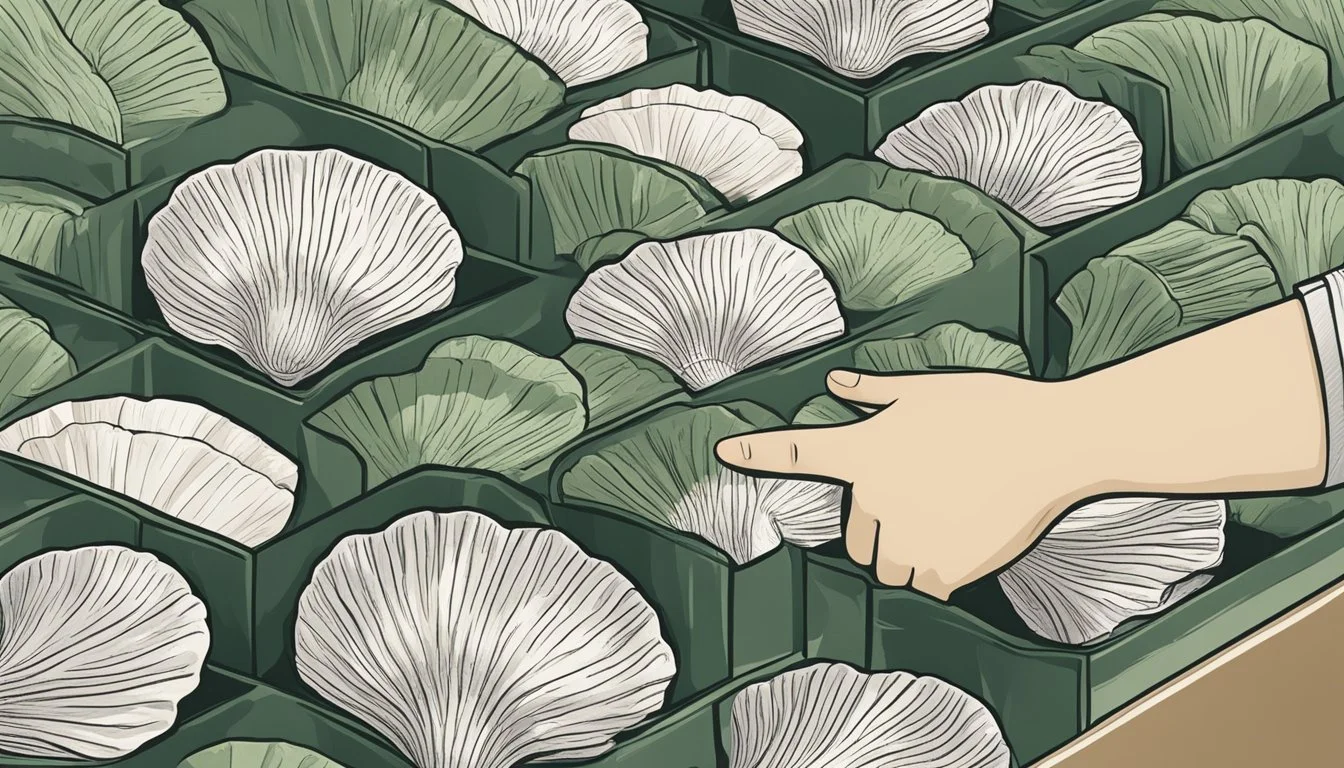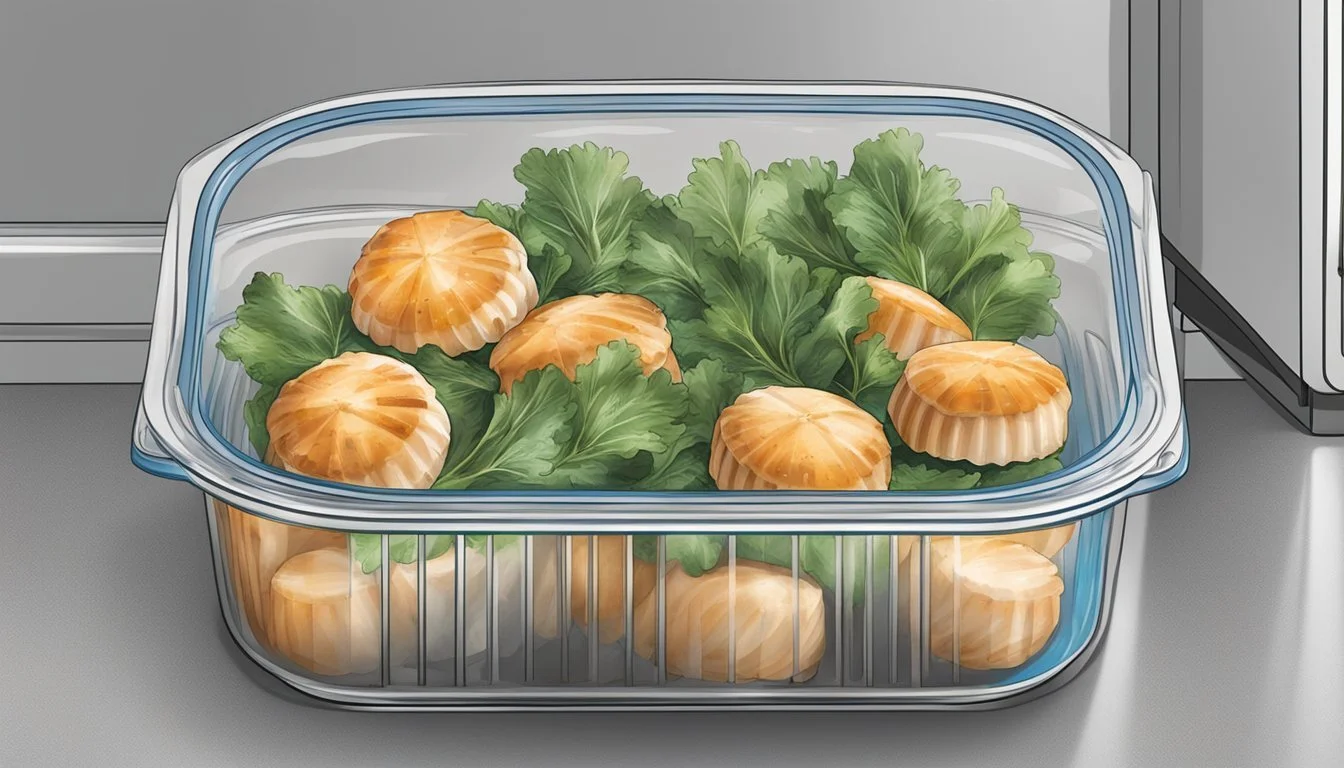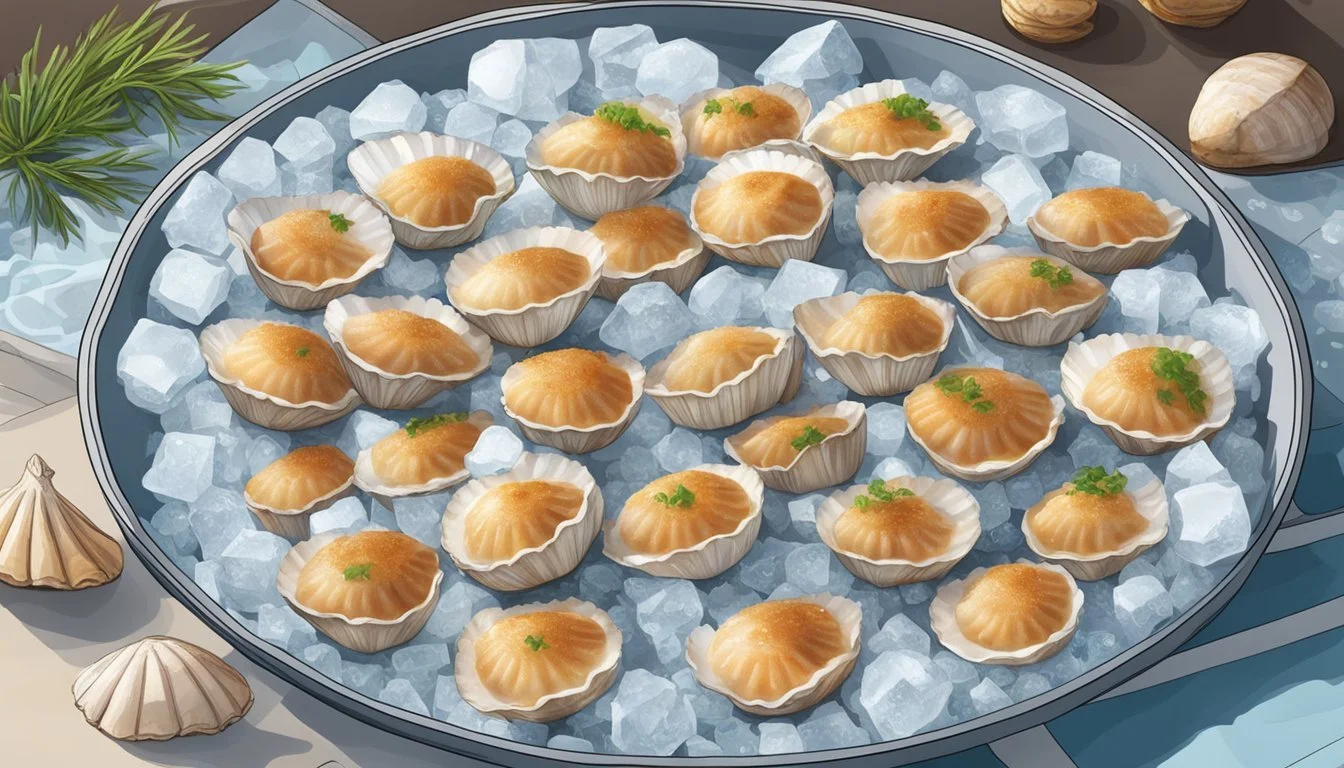How Long Do Scallops Last?
Shelf Life and Storage Tips
Scallops (What wine goes well with scallops?) are a prized seafood delicacy known for their delicate texture and sweet flavor. As a perishable item, the shelf life of scallops is an important consideration for maintaining their quality and ensuring freshness. The shelf life of scallops varies depending on whether they are stored in the fridge or freezer, and whether they are kept in their shells, shucked, or cooked.
When refrigerated at a temperature between 32°F and 38°F (0°C and 3°C), raw scallops can remain fresh for up to two to three days. Scallops that have been shucked can last up to five days in the fridge. It's essential for consumers to store them properly in sealed containers or zip-top bags to prevent cross-contamination. In contrast, the freezer extends the shelf life of raw scallops significantly, where they can maintain quality for around three months.
To determine if scallops have gone bad, they should be examined for any sour smell, dull color, or slimy texture. These are indicators that the scallops are no longer fresh and should be discarded. It's critical for both culinary enthusiasts and casual cooks to understand these storage guidelines to enjoy scallops at their best quality and avoid the risks associated with spoiled seafood.
Understanding Scallop Shelf Life
When it comes to preserving the quality and safety of scallops, understanding their shelf life is crucial. Shelf life varies significantly depending on whether the scallops are fresh, cooked, or frozen, and proper storage methods are essential to extend it.
Shelf Life of Fresh Scallops
Fresh scallops, when stored in the refrigerator, have an optimal shelf life of up to two days. To ensure maximum freshness, they should be kept at a constant refrigerator temperature of 32-38°F (0-3°C). Scallops should be placed in the coldest part of the fridge, typically at the back, away from the door. They are best stored in a covered container or wrapped in a moist paper towel and placed inside a sealable bag.
Shelf Life of Cooked Scallops
Cooked scallops, once cooled, can be stored in the refrigerator where they will retain quality for 3 to 4 days. They should be kept in an airtight container to avoid contamination and absorption of other flavors and odors in the fridge. It's imperative to store them quickly after cooking, as they should not remain at room temperature for longer than two hours to prevent bacterial growth.
Freezer Shelf Life for Scallops
Freezing provides a long-term solution for extending the life of scallops, with fresh scallops lasting up to six months in the freezer. This is dependent on proper preparation before freezing, which includes rinsing them in cold water, patting them dry, and placing them in a freezer-safe container or bag. However, for those previously frozen then thawed, raw scallops should be consumed within 1-2 days for best quality, while cooked ones can last in the freezer for up to 3 months. It’s important to safeguard against freezer burn, which can compromise the taste and texture of the scallops.
Signs of Spoilage
When inspecting scallops for freshness, it is crucial to be aware of visual, olfactory, and textural indicators which signal spoilage. One should discard scallops if they exhibit any signs that they have gone bad to ensure food safety.
Visual Indicators
Scallops should have a healthy, slightly translucent or cream color. If they display:
Discoloration: Any dullness or unnatural coloring can be a cause for concern.
Opacity: A loss of their natural translucency may indicate spoilage.
These visual cues suggest that scallops may have gone bad and should be discarded.
Olfactory Indicators
Fresh scallops have a sweet, briny scent. Spoiled scallops, on the other hand, may emit:
Sour Smell: A clear indicator that scallops are no longer fresh.
Off-Putting Odors: Any strong, unpleasant smells are a warning sign.
Odors that deviate from the normal briny scent are reliable indicators of bad scallops.
Textural Indicators
The feel of scallops can also signify their condition. Scallops should be:
Firm: They should have a consistent firmness throughout.
Not Slimy: A slimy texture is a telltale sign that scallops should be thrown away.
Any scallop that has become slimy to the touch or noticeably softer has likely spoiled and should not be consumed.
Proper Storage Techniques
Proper storage is crucial for maximizing the shelf life of scallops and maintaining their quality. The guidelines provided here follow strict food safety protocols, ensuring scallops are stored correctly to prevent spoilage and foodborne illness.
Refrigeration Guidelines
When refrigerating scallops, they should be placed in the coldest part of the refrigerator. For optimum freshness:
Temperature: Maintain a consistent refrigerator temperature between 32°F (0°C) and 38°F (3°C).
Containers: Store scallops in airtight containers or wrap them tightly in plastic wrap to reduce exposure to air.
Shelf Life: Raw scallops should be consumed within two to three days, while cooked scallops can last up to four days when refrigerated.
Freezing and Thawing Methods
Freezing scallops correctly extends their shelf life without sacrificing their quality. These steps should be followed for proper freezing and thawing:
Temperature: Set the freezer to 0°F (-18°C) or below.
Packaging: Place scallops in airtight containers or freezer bags, expelling as much air as possible before sealing.
Shelf Life: Frozen scallops can be stored for approximately three months to maintain quality.
Thawing: To defrost, place the frozen scallops in the refrigerator overnight. It ensures that scallops are thawed evenly and remain at a safe temperature, reducing the risk of bacterial growth. Once defrosted, scallops should not be refrozen and should be cooked within 24 hours.
Safe Handling Practices
When dealing with scallops, adhering to safe handling practices is essential to prevent foodborne illness and ensure that the seafood remains safe to eat. Proper handling can mitigate risks of cross-contamination and preserve the quality and safety of the scallops.
Preventing Cross-Contamination
Cross-contamination can occur when bacteria or other harmful microorganisms are unintentionally transferred from one surface to another. To prevent this:
Always wash hands thoroughly before and after handling scallops.
Use separate cutting boards and knives for scallops and other foods, especially raw meats.
Clean all surfaces and utensils with hot, soapy water or a disinfectant after they come into contact with raw scallops.
Keep scallops and their juices away from other food items in both the refrigerator and during preparation.
Best Practices for Thawing
Scallops should be thawed safely to minimize the risk of bacterial growth. The best methods to defrost scallops include:
Refrigerator Thawing: Transfer scallops from the freezer to the refrigerator and allow them to thaw slowly, usually overnight. Keep them in a covered dish to prevent cross-contamination.
Cold Water Thawing: Seal scallops in a leak-proof plastic bag and submerge them in cold water, changing the water every 30 minutes to ensure it remains cold. It is not safe to thaw scallops in hot or warm water.
Microwave Thawing: As a quicker option, scallops can be thawed in the microwave. Use the defrost setting and handle them immediately after thawing to cook or refrigerate.
For best results, once thawed, cook scallops promptly to maintain quality and ensure they remain safe to eat. Thawed scallops should be cooked or refrigerated within 1-2 days.
Maximizing Scallop Quality
Freshness and proper cooking techniques are pivotal when it comes to maximizing the quality of scallops. Ensuring both flavor and texture are preserved hinges on these factors, whether the scallops are served raw like in sushi (What wine goes well with sushi?) or cooked.
Determining Scallop Freshness
Visual Inspection: Fresh scallops should have a bright, moist appearance without any discoloration. They are typically creamy white or slightly pink.
Smell Test: They should emit a sweet, sea breeze-like odor; a strong fishy smell indicates they are past their prime.
Texture: High-quality fresh scallops should feel firm to the touch, with a slightly moist surface, not slimy or dry.
By discerning freshness meticulously, one can ensure the foundation for delightful flavor and texture.
Optimal Cooking Techniques
Raw Preparation: To preserve quality for sushi or sashimi, scallops must be exceptionally fresh with a firm texture, then sliced properly and served promptly.
Cooking Methods: Gentle searing, grilling, or stir-frying are recommended to enhance the natural sweetness without overcooking, which can result in toughness.
For Cooked Scallops:
Optimal cooking time for scallops ranges from 1 to 2 minutes per side when searing.
When reheating, it's crucial to use a method that won't dry them out, like a brief stint in a preheated oven.
Utilizing these techniques rightfully enhances the intrinsic flavor and quality of the scallops.
Foodborne Illness Prevention
When it comes to scallops, preventing foodborne illness is paramount. One must adhere to food safety guidelines to avoid the occurrence of spoilage and growth of harmful bacteria.
Recognizing Harmful Bacteria
It's crucial for individuals to identify potential threats from harmful bacteria that can induce foodborne illness. Vibrio, for instance, is a bacteria commonly associated with seafood, including scallops, which can cause symptoms such as watery diarrhea, stomach cramping, and nausea. These symptoms typically emerge within a day of consuming contaminated seafood and can last about three days.
To ensure safety and prevent illness:
Storage: Store raw scallops in the fridge for up to three days if they are in their shells. Shucked raw scallops can last five days in the fridge, while cooked scallops should be consumed within four days.
Temperature: Keep scallops refrigerated at or below 40°F (4°C) to inhibit the growth of bacteria.
Cooking: Thoroughly cook scallops to an internal temperature of 145°F (63°C) to eliminate harmful bacteria. Cooking methods and times (boiling for at least 3 minutes, frying in oil at 375°F for 3 minutes, or broiling 3 inches from heat for 3 minutes) are critical in reducing the risk of foodborne illness.
Hygiene: Always practice good hygiene by washing hands, utensils, and surfaces with soap and water before and after handling scallops.
By following these specific guidelines, consumers can enjoy scallops while minimizing the risk of foodborne illness.
Usage and Servings
Scallops are a versatile seafood with specific serving suggestions that can enhance various dishes. Their delicate taste allows them to pair well with numerous cooking styles.
Incorporating into Dishes
Scallops can be a standout ingredient in an array of culinary creations. Sea scallops, larger in size, are particularly favorable in dishes where they serve as the main protein. They can be seared to a golden-brown perfection and added to pasta or placed atop a fresh salad. For sushi preparations, scallops offer a sweet, mild flavor that complements the sushi rice and other ingredients. In a stir-fry, scallops cook quickly and absorb sauces well, which can elevate the overall taste and quality of the dish.
Proper Portioning
The proper portioning of scallops can vary depending on the recipe and the diner's dietary needs. However, a common guideline for a single serving is 3.5 ounces, or approximately 2-3 large sea scallops or 4-5 medium-sized scallops.
For salads: A standard serving could include a handful of small scallops, adding protein without overwhelming the other salad ingredients.
Within pasta dishes: Balancing the ratio of scallops to pasta ensures every bite contains a harmonious mix of textures.
In stir-fries: The portion of scallops should be kept in check with the volume of vegetables and grains.
When serving scallops, one should ensure they're cooked to the proper doneness, as overcooking can lead to a rubbery texture, while undercooking could pose a risk to food safety.
FAQs: Scallops Storage and Safety
How long can scallops be stored in the refrigerator?
Raw scallops: They should be used within 1-2 days after thawing or purchasing fresh. Cooked scallops: These are safe for consumption within 3-4 days when stored in the refrigerator.
What are the freezer storage times for scallops?
Scallops can be stored in the freezer where
Raw scallops: will maintain quality for up to three months.
Cooked scallops: can last up to 2-3 months.
How can one tell if scallops have gone bad?
They should be discarded if displaying any of the following:
Sour smell
Dull color
Slimy texture
What is the best way to freeze scallops?
Scallops should be placed in a freezer-safe bag or container, ensuring air is removed to prevent freezer burn. Label with the date of freezing.
Can you refreeze scallops?
It is generally not recommended to refreeze scallops as it can significantly degrade their quality and safety.
How should leftover cooked scallops be stored?
Leftovers should be placed in airtight containers and refrigerated as soon as possible. Consume them within the recommended 3-4 days.
Note: Always maintain a temperature of 0°F (-18°C) in the freezer and 40°F (4°C) or below in the refrigerator to ensure the safety and quality of the scallops.
Refrigerator Storage Tips
When storing scallops in a refrigerator, food safety and freshness are paramount. To ensure scallops remain safe and retain their quality, one must observe proper storage conditions.
Scallops should ideally be refrigerated at temperatures between 32°F and 38°F. This temperature range inhibits bacterial growth and helps maintain the scallops' freshness. One can use a refrigerator thermometer to consistently monitor temperature, ensuring it remains within this safe range.
Upon bringing scallops home, they should be placed in proper storage containers, such as a sealed container or zip-top bag. This practice prevents cross-contamination with other foods. It's important to store them in the coldest part of the refrigerator, typically at the back, away from the door where temperature fluctuations are more common.
If scallops are still in their shells, they can be refrigerated in this state. Once shucked, scallops should be wrapped in moisture-proof paper or placed in an airtight container before returning them to the fridge.
Here is a brief guide on how long scallops can be kept refrigerated:
State of Scallops Refrigerated Life Expectancy In-shell Raw Scallops Up to 3 days Shucked Raw Scallops 1-2 days Cooked Scallops Up to 4 days
Remember, these durations are approximate, and the assigned freshness window can vary based on the exact conditions within one's refrigerator and the initial freshness of the scallops. Always inspect seafood for signs of spoilage—such as an unusual smell or a slimy texture—before preparation and consumption.
Freezer Storage Tips
When storing scallops in the freezer, one should utilize a method that limits exposure to air, as this can cause freezer burn and compromise the quality of the scallops. It is advisable to use thick, freezer bags or airtight containers to ensure the scallops are well-protected. Before sealing the seafood, it is crucial to remove as much air as possible from the freezer bags to reduce the risk of freezer burn.
Here are some steps they can follow for optimal storage:
Rinse scallops under cold water, and gently pat dry with a paper towel.
Place the scallops in a single layer on a tray or flat surface, ensuring they are not touching, and freeze them briefly before sealing. This pre-freezing step helps prevent the scallops from sticking together.
Once slightly frozen, transfer the scallops into a freezer bag or an airtight container.
For extra protection, one can wrap the scallops in aluminum foil before placing them in a bag or container. Label each package with the date of freezing to keep track of how long they have been stored.
Scallops may be stored in the freezer for up to six months. However, for best quality, they should consider using them within three months. The coldest part of the freezer is typically at the back, away from the door, which is where they should store the scallops to maintain their quality.
By following these guidelines, one ensures the longevity and freshness of scallops during freezer storage.
Handling and Preparation
When preparing scallops, it is essential they handle them with care to prevent cross-contamination. Prior to storing or cooking, one should thoroughly rinse scallops under cold water and gently pat them dry with a paper towel. This process helps to remove any lingering bacteria and grit.
Storage: Immediately after purchasing, one should transfer the scallops to a refrigerator or freezer. For refrigeration, they should ensure that scallops are stored in an airtight container or resealable plastic bag. To prevent any leakage and potential cross-contamination in the refrigerator, storing the container or bag on the lowest shelf is advisable.
For Freezing:
Rinse scallops in cold water.
Pat them dry.
Place in a freezer-safe container or bag.
Label with the current date.
Fridge Prep:
Keep scallops in the coldest part of the fridge.
Use a covered dish or a sealed bag.
If scallops are in a package, ensure it’s intact to prevent exposure to air.
Cross-contamination can occur if scallops come into contact with surfaces or utensils that have been used for raw meats. Always use separate cutting boards and knives for seafood and other meats. It's also critical to wash hands thoroughly before and after handling raw scallops.
During preparation, one should avoid leaving the scallops at room temperature for extended periods, as harmful bacteria can grow rapidly. Instead, scallops should be prepared for cooking soon after removing them from refrigeration. If any ice glaze is present, a gentle rinse before cooking can remove it.
Selecting Quality Scallops
When choosing scallops, one should focus on the quality and freshness, which are pivotal to the taste and safety of this seafood. Quality is often a reflection of the source and the handling post-harvest.
Sourcing from Reputable Suppliers
It is imperative to obtain scallops from reputable sources. A trustworthy supplier should have transparent practices about where and how the scallops were harvested. One should inquire if the scallops are:
Wild-caught or sustainably farmed
Harvested with environmentally friendly methods
Inspecting for Freshness
Scallops should be assessed for freshness before purchase, particularly looking at:
Texture: Quality scallops should be firm to the touch, but still slightly moist.
Color: Fresh scallops typically have a consistent, light-creamy to a slightly pink or beige color.
If the scallops are shucked, check for a sweet, briny scent and avoid any with a sour smell or slimy texture.
Storing Leftovers
When dealing with leftovers, particularly cooked scallops, proper storage is imperative for maintaining quality and safety. Leftovers should be refrigerated as soon as possible, ideally within 2 hours of cooking. This time window helps prevent bacterial growth that can occur at room temperature.
Refrigeration: Cooked scallops should be stored in the refrigerator at a temperature below 40°F (4°C). This cool environment keeps the scallops safe from bacteria that thrive at warmer temperatures.
Containers: For optimal freshness, one should place the cooked scallops in shallow airtight containers. Tightly sealing the food not only preserves its quality but also prevents the scallops from absorbing any odors from the refrigerator.
Storage Method Expected Shelf Life Refrigerator (at <40°F) 3 to 4 days Freezer (in airtight container) Several months
It's important to note that while refrigeration slows down bacterial growth, it doesn't halt it entirely. Cooked scallops typically maintain their quality for 3 to 4 days when refrigerated properly. If one plans to keep the scallops longer, freezing is an option that can extend their shelf life by several months, provided they are stored in airtight containers or wrapped tightly with heavy-duty aluminum foil or plastic wrap.
Upon consuming leftovers, one should assess both the smell and texture of the scallops. Any signs of spoilage, such as an off odor or a slimy texture, indicate that the scallops are no longer safe to eat and should be discarded.
When to Discard Scallops
When assessing whether scallops have gone bad, individuals should pay close attention to a few key indicators that signal the seafood is no longer at its peak quality and should be discarded. Here is a concise guide on when scallops should be considered no longer safe or optimal for consumption:
Smell: Fresh scallops should have a sweet, mildly briny scent. If scallops emit a sour smell or an off-putting odor, they should be discarded immediately.
Texture: Scallops should feel firm to the touch. If they have become slimy or mushy, it is a sign that they have spoiled and should not be consumed.
Color: While fresh scallops are usually a creamy white or a light pinkish shade, any significant discoloration is a cue that the seafood may have gone bad. Look for unusual spots or an opaque appearance as signs of spoilage.
Time: Scallops have a limited shelf life. If raw scallops are kept in the refrigerator for longer than three days (shucked) or up to five days (in the shell), they should be discarded. Cooked scallops are best consumed within four days of cooking.
The following table outlines key indicators to be aware of:
Indicator Description Action Sour Smell Off-putting or sour odor Discard Texture Slimy or overly soft Discard Color Discoloration or dull color Discard Time in Fridge Exceeds 3-5 days (raw), 4 days (cooked) Discard
Consumers must consistently practice food safety and discard scallops if they exhibit any signs of spoilage to ensure they are only consuming seafood of the highest quality and to avoid foodborne illnesses.
Common Myths and Misconceptions
Myth 1: Scallops Can Be Refreezed Multiple Times Without Risk
Many believe that scallops, once thawed, can be safely refrozen for later use. However, refreezing can compromise food safety and degrade the flavor and texture of scallops. Each thawing cycle increases the risk of bacterial growth, which can lead to foodborne illness. Therefore, it's advised to only freeze and thaw scallops once.
Myth 2: There's No Way to Tell if Scallops Have Spoiled
Contrary to popular belief, one can detect bad scallops through their smell, color, and texture. Fresh scallops should have a slightly sweet ocean scent. Any sour or ammonia-like odor indicates spoilage. Additionally, scallops should have a moist, not slimy texture, and retain a bright, uniform color.
Myth 3: Frozen Scallops Retain Their Taste Indefinitely
While freezing extends the shelf life of scallops, the taste and quality diminish over time. Ideally, scallops should be consumed within six months when frozen to ensure optimal flavor.
Myth 4: Refreezing Restores Scallops' Freshness
Some may think that refreezing scallops can help restore their 'just-caught' freshness. However, once scallops are thawed, enzymes become active, leading to a decline in quality. Refreezing only prolongs storage time, not freshness.
Status Indicator Fresh Sweet scent, bright color, firm texture Spoiled Sour odor, dull color, slimy texture
Frequent thawing and refreezing also results in texture changes, affecting how scallops cook and taste. For preserving the integrity of scallops, one should practice cautious thawing and avoid repeated refreezing cycles.
Conclusion
When it comes to preserving scallops, storage time and methods are paramount. Raw scallops have a brief refrigerated shelf life, typically lasting up to three days when kept in their shells and up to five days if shucked. If one opts to cook the scallops, they can expect these to remain suitable for consumption for up to four days when refrigerated.
For longer-term storage, freezing is recommended. Raw scallops maintain quality in the freezer for three to six months, whereas cooked scallops can be stored frozen for two to three months. It's critical to ensure scallops are stored in airtight, freezer-safe containers to extend their shelf life and prevent freezer burn.
Here's a quick reference table summarizing the storage times:
State of Scallops Fridge (up to) Freezer (up to) Raw, In Shell 3 days Not recommended Raw, Shucked 5 days 3-6 months Cooked 4 days 2-3 months
It's essential to note that these guidelines assume the scallops have been continuously kept at a safe temperature and are not subjected to repeated temperature changes. Consumers should rely on their senses, too—if the scallops smell off or have a slimy texture, they should be discarded. Safety must always take precedence above extending the shelf life of seafood.

